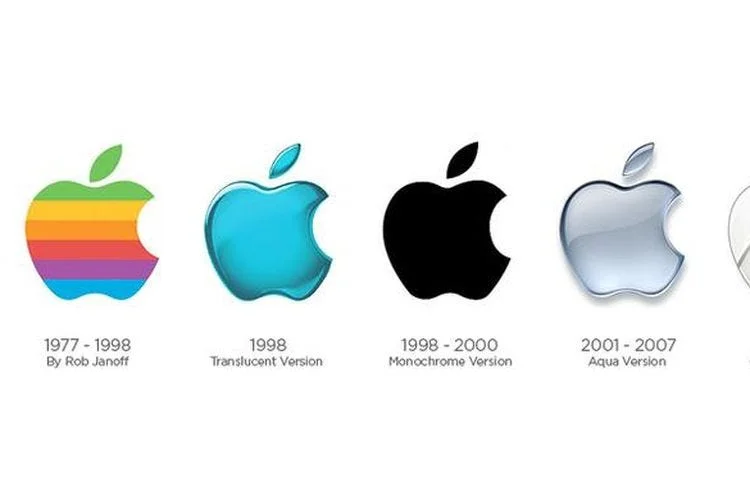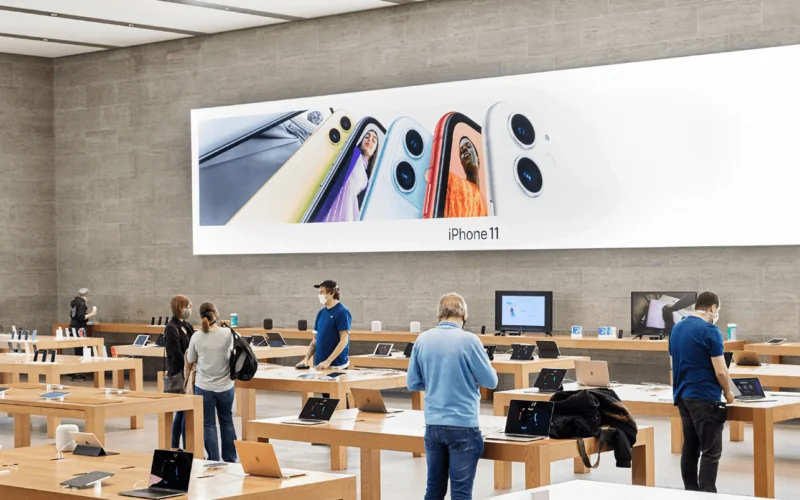The Apple retail strategy and store design have been major factor in the company's success. Through its unique and innovative approach, Apple has established itself as an industry leader in the field of customer experience.
The purpose of this article is to examine how Apple's retail strategy and store design contribute to its overall business performance. An analysis of this topic will include examining key elements such as product placement, visual merchandising, technological capabilities, and service offerings.
Additionally, an examination of consumer behavior trends within the stores will be conducted in order to evaluate the effectiveness of Apple's retail strategies. By understanding these factors, it is possible to gain insight into why Apple's stores are so successful and what other retailers can learn from them.
READ ALSO: Apple's Supply Chain and Manufacturing Process
Product Placement in Apple Store
Product placement in Apple stores is as essential to their retail strategy as the mortar and bricks of the store itself. It is a crucial element that not only influences customer flow but also provides accessibility solutions for customers looking to purchase items.

When it comes to product placement, Apple has created an efficient system that allows shoppers to find what they are looking for quickly and easily while providing them with good visibility of all products throughout the store.
The layout of each Apple store follows similar principles no matter where it may be located; this ensures consistency across different locations and a smooth transition from one store design to another.
Products are placed in strategic areas within the store so there can be maximum exposure without overcrowding any particular area or creating too much clutter in any given space.
Shelves are kept neat and tidy with displays updated regularly, making sure everything looks inviting when customers enter the shop.
Moreover, by placing products closer together, Apple creates a sense of urgency toward buying certain items which helps drive sales overall.
Apple's use of visual merchandising techniques such as lighting fixtures and signposts further reinforces its product placement strategies by drawing attention directly to specific products on display.
This encourages exploration amongst customers who might otherwise overlook certain items or have difficulty navigating around the store due to limited mobility issues – thus making shopping easier for everyone involved.
All these elements come together into a cohesive plan designed to maximize customer satisfaction while still increasing profits – something Apple excels at doing well. Moving onto visual merchandising…
Visual Merchandising
In order to maximize its retail strategy and store design, Apple has adopted a highly successful visual merchandising approach. This involves creating an aesthetically appealing display that draws customers in and encourages them to purchase products.

Visual displays are used to create the desired atmosphere while also showcasing specific items and increasing the visibility of those products.
Sales tactics such as promotional offers, discounts, and other incentives help boost sales by incentivizing customers to make purchases. Many retailers implement these tactics through signage or digital displays in their stores which allows for easy access to information about current deals.
Additionally, these strategies can be used online with targeted emails or on social media platforms like Instagram or Twitter.
Apple's innovative technology capabilities have allowed it the opportunity to further enhance its retail strategy and store design with advances in virtual reality (VR) and augmented reality (AR). For example, shoppers can use VR headsets at certain locations within Apple Stores allowing them to experience product demos without actually needing physical sample units.
AR enables users to place 3D images of furniture pieces in their homes before making a purchase decision. Through creative integration of technology into its retail spaces, Apple is able to offer exceptional customer experiences that drive loyalty amongst consumers.
READ ALSO: Apple's Customer Experience and Loyalty
Technological Capabilities
It has long been said that Apple's retail strategy and store design outpace the competition in terms of technological capabilities. While others struggle to catch up, Apple continues to innovate with interactive displays and augmented reality experiences for customers.
This is evidenced by:
- The use of technology-enhanced shopping experiences such as 3D product models, online order pickup kiosks, and smart mirrors;
- Proprietary mobile app integration into their stores allowing customers to access products without ever speaking to a salesperson;
- Interactive displays offering immersive customer support services like guided tours or personalized recommendations.
These features are just the tip of the iceberg when it comes to Apple's dedication to blurring the lines between physical and digital commerce through its retail strategy and store design.
With this commitment firmly established, attention now shifts towards how they can use these same principles to improve their service offerings.
Service Offerings
Apple's retail strategy and store design are also underpinned by their service offerings. These services range from staff training aimed at providing an exceptional customer experience to initiatives that drive customer loyalty.
Staff members receive comprehensive skill-building training, with the goal of equipping them with the knowledge they need to assist customers in a timely manner and deliver top-notch service quality on Apple products.
Customers can take advantage of loyalty programs such as the “My Apple Rewards” program which allows users to earn points and special discounts for each purchase made through Apple stores or online platforms.
The focus placed on both employee and consumer needs is evident in Apple's commitment to ensuring that its store designs provide extraordinary experiences for all shoppers.
By incorporating elements such as open-plan layouts, interactive features, digital displays, and product zones, Apple seeks to create a truly immersive shopping environment.
With locations worldwide, many stores feature educational workshops and events tailored specifically for different user groups such as developers or educators. This approach ensures that customers have access to the help they need when using any of Apple's products or services.
In order to stay ahead of trends in consumer behavior and technological advancements, Apple continues to prioritize strategic investments in its retail presence across multiple markets around the world.
While there are still many opportunities available for further improvement within this sector of their business model, it is clear that Apple has put considerable effort into creating an exemplary retail ecosystem for customers everywhere.
As technology evolves so too will consumer expectations; therefore it is essential that companies like Apple remain agile enough to adjust accordingly while continuing to innovate new solutions going forward.
This ever-changing landscape brings us now into analyzing consumer behavior trends…
Consumer Behavior Trends
Online shopping habits have been steadily increasing in recent years, with consumers preferring the convenience of the online shopping experience.
Brand loyalty has become a key factor in driving customer decisions, with customer loyalty towards certain brands often resulting in customers being willing to pay more for their desired products.
Apple's retail strategy and store design must take into consideration customers' online shopping habits, as well as how to capitalize on customer loyalty in order to remain competitive in the digital retail space.
As such, Apple must find a way to effectively balance its online presence with its brick-and-mortar stores in order to remain a leader in the consumer behavior trends of the future.
Online Shopping Habits
Recent consumer behavior trends have revealed a shift in shopping patterns towards online purchasing. Consumers are increasingly leveraging the internet to compare prices and make informed decisions, taking advantage of the convenience an e-commerce platform can provide.
This has been further reinforced by increasing levels of comfort with technology, as well as more accessible digital devices and platforms providing access to this type of information.
In addition, social media channels such as product reviews on websites like Yelp or Amazon enable customers to easily find out what other shoppers think about certain products before making their purchase decision.
Therefore, it is vital that retail stores take these changing behaviors into consideration when devising their retail strategy and store design in order to remain competitive.
To do so, they must ensure that their physical locations offer unique experiences which cannot be replicated through online shopping, while also integrating technological advancements in order to capture data from customer interactions for better insights into consumer spending habits.
Impact Of Brand Loyalty
As consumer behavior trends continue to evolve, brand loyalty has emerged as a major factor in the success of retailers.
Brand recognition is critical for building customer trust and driving repeat purchases, while loyalty rewards can incentivize customers to remain loyal to a specific store or product.
To capitalize on this, retail stores must focus on developing strong relationships with their customers by providing consistent quality experiences, reliable customer service and personalization opportunities that cater to individual preferences.
By doing so, they can create an emotional connection between the consumer and the store which will lead to increased brand loyalty and more frequent visits from existing customers.
Ultimately, this can help build long-term relationships with shoppers and increase overall sales figures year-over-year.
READ ALSO: Apple's Software and Operating Systems
Apple Experiential Design
Apple's retail strategy involves experiential design, which is the use of design to engage customers in unique ways. Their stores are built on strong foundations of community events and design psychology, emphasizing customer focus and engagement.
A key component of their store designs is creating distinct experiences that foster a sense of belonging and connection between customers and Apple products.
This involves organizing spaces into easy-to-navigate areas with interactive displays that allow customers to explore different product features. In addition, they often host special events at their stores such as workshops, seminars, concerts, and other activities aimed at strengthening community ties.
Design psychology plays an important role in Apple Retail Stores by influencing how people interact with technology and brands while shopping. For example, they may create inviting atmospheres through the placement of furniture or lighting fixtures that encourages wandering around the store rather than just quickly passing through it.
They also emphasize color palettes throughout the store that evoke certain emotions from visitors such as joy or excitement when viewing new items for sale.
This helps build brand loyalty by making shoppers feel like part of something larger than themselves whenever they enter an Apple Store. The goal of Apple's retail strategy is to make visiting one of its stores not only a place where you can buy products but also an experience in itself.
By understanding how consumers think about shopping and incorporating both physical elements along with social interaction within each space, Apple has been able to successfully craft its own unique identity within the market – one that still sticks today.
Moving forward, this emphasis on experiential design will continue to be an integral part of their success story as they look ahead towards establishing a strong brand identity amongst consumers worldwide.
Apple Brand Identity
Having looked into the experiential design of Apple's retail strategy and store design, it is now time to discuss brand identity. Brand identity is an essential part of creating a successful retail environment that builds emotional connections with customers and encourages customer loyalty.

The key aspects of creating a strong brand identity are consistency, clarity, and corporate culture. Customers should be able to recognize the Apple brand through its use of colors, logos, fonts, marketing messages, images, and other visual elements which will help them connect emotionally with the company as well as increase their loyalty towards it.
Here are four ways in which this can be achieved:
- Using consistent visuals throughout all physical locations;
- Establishing clear guidelines for messaging across all channels used by the company;
- Ensuring the corporate culture reflects positive values;
- Creating a unique atmosphere within each location that conveys those values.
Apple has successfully implemented these techniques to create a unified brand identity amongst its stores worldwide. By doing so they have created long-lasting relationships with customers who appreciate the synergy between their online and offline experiences.
With digital integration being such an important factor in modern-day business strategies, this seamless transition from one platform to another plays a major role in building trust among customers and contributing to success.
READ ALSO: Evolution of Apple's Logo and Branding
Digital Integration
In Apple's retail strategy and store design, digital integration plays a major role in the customer experience. Social media has become increasingly important for retailers to reach out to customers, build brand loyalty, and develop relationships with potential buyers.
Likewise, mobile apps provide an engaging platform for customers to access offers and information about products quickly on their phones or tablets.
The following table outlines key considerations when utilizing social media and mobile applications as part of Apple's retail strategy:
| Social Media | Mobile Apps |
|---|---|
| – Developing content that is relevant to the target audience | – Creating a user-friendly interface that appeals to all ages groups |
| – Exploring possibilities of interactive campaigns such as quizzes/contests etc. | – Ensuring up-to-date product information is accessible through app features like virtual assistant bots (e.g Siri) |
| – Maintaining clear guidelines & protocols regarding replying to comments/queries from users. | – Offering exclusive deals via push notifications or emails sent directly through the app itself. |
These strategies are essential in order to ensure that customers have the best possible experience while shopping at Apple stores.
By leveraging both social media platforms and mobile applications, Apple can further enhance its customer engagement initiatives by providing timely updates on new product launches, promotions, upcoming events, etc., which ultimately leads to increased sales revenue.
Moreover, it also allows them to maintain close ties with existing customers while building trust with potential buyers too.
READ ALSO: Apple's Patent and Intellectual Property Strategy
Frequently Asked Questions About Apple Retail Strategy and Store Design
What Is The Cost Of Apple Products?
When considering the price range of Apple products, it is important to understand how they relate to their buying experience.
Generally speaking, Apple products are well-priced for the quality and features that come with them.
Though initial purchase prices may be higher than other competitors, customers have access to a wide range of support services such as online tutorials and in-store technical assistance.
Additionally, Apple's retail strategy and store design offers an enjoyable shopping experience for customers who prefer physical stores over online retailers.
This can help justify the cost of purchasing Apple products by providing further value beyond just the product itself.
How Often Do Apple Stores Restock Their Inventory?
Inventory management is a key element of the in-store layout and the frequency of restocking impacts customer satisfaction.
Apple Stores generally restock their shelves every three to four weeks due to their well-organized inventory system.
This allows them to keep up with changing stock levels while ensuring customers have access to the latest products.
By having an efficient inventory management strategy, Apple maintains a high level of customer service within its stores and ensures that shoppers can find what they need quickly and easily.
What Are The Store Hours For Apple Stores?
Apple stores have specific store hours that are typically 9 am to 8 pm Monday through Saturday and 12 pm to 6 pm on Sundays.
As a result of their retail strategy, Apple has implemented a unique store layout that includes winding pathways that lead customers throughout the store while providing ample room for customer service stations and product displays.
This design encourages customers to explore the space as they move from one area to another, allowing them to experience more of what Apple's products can offer.
Are There Any Discounts Available At Apple Stores?
The retail experience at Apple Stores is renowned for its exceptional customer service and exclusive products.
To further enhance their shopping journey, shoppers can take advantage of discounts available through various means such as discount eligibility and rewards programs.
Eligibility relies on memberships and promotions while rewards can be earned by signing up for the store's loyalty program.
The availability of these incentives has been found to encourage customers to purchase more frequently while contributing to an overall positive customer experience.
What Payment Methods Does Apple Accept?
Apple, a major technology company, offers a multitude of payment methods which include cashless payments and online ordering.
Apple stores accept various credit cards such as Visa, MasterCard, American Express, Discover Card, store-branded debit cards (such as Target's REDcard), and digital wallets including Apple Pay and Google Pay.
Additionally, customers can purchase products with gift cards or use financing options through third-party vendors. In some cases, consumers may also redeem rewards points at the point of sale to pay for purchases.
All of these payment methods are accepted in order to accommodate customer preferences and increase overall sales potential within the retail environment.
Conclusion
Apple's retail strategy and store design have proved to be successful in providing customers with an enjoyable shopping experience.
By offering a range of products at competitive prices, stocking up their inventory regularly, and staying open for extended hours, Apple has created an environment that is both customer-friendly and profitable.
Furthermore, the payment options available are convenient and varied; this allows customers to choose whichever option suits them best.
In conclusion, Apple continues to demonstrate its commitment to customer service excellence through its well-designed stores that offer value for money.
This has allowed them to remain one of the top contenders in the electronics retail industry.
Thank you for reading our article today! Please remember to share this article on social media to help others benefit too. It also helps us improve our algorithm and relevance to the public. Thanks for Sharring!!! Follow us on Socials: Facebook - LinkedIn - Twitter









